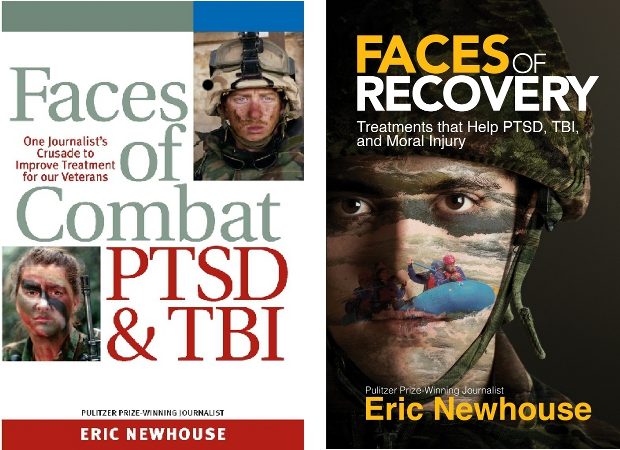Faces of Recovery
Faces of Recovery continues the report on how millions of American soldiers have faced the ultimate dilemma: kill the enemy or risk being killed yourself. As documented in Eric Newhouse’s earlier book, Faces of Combat, PTSD & TBI, each choice traumatizes the brain. The trauma is cumulative—prolonged combat increases emotional and physical injury.
This book also introduces a newly discovered complication, moral injury. It occurs when soldiers are ordered into a conflict they cannot morally justify, yet are forced to kill others to stay alive themselves. It happens when soldiers feel their chain of command has betrayed or abandoned them. It can also occur when a soldier has violated their own moral code, for example by killing civilians to avenge the death of friends, or when they fail to protect the buddies who have been watching their backs.
Faces of Recovery looks at the personal steps each veteran must take to feel accepted again in society. These include forgiveness, making atonement, self-forgiveness, and physical exercise to help the brain reduce depression and anxiety.
Buy this book from Idyll Arbor
Faces of Combat
Millions of American soldiers have faced the ultimate dilemma: Kill the enemy or risk being killed. Each choice traumatizes the human brain. Too many tours, too many roadside bombs, too many mortar attacks increase the likelihood of post-traumatic stress disorder (PTSD). Half a million soldiers could come back from Iraq and Afghanistan needing our help to live normal lives.
Eric Newhouse, Pulitzer Prize winning journalist, writes about the coming crisis of veterans returning from combat with PTSD and traumatic brain injuries (TBI). The huge numbers of returning veterans threaten to overwhelm health care facilities that are already overloaded, clogged with bureaucracy, and overly reliant on prescribing medications. Newhouse lets the veterans tell you what they’ve been through in combat and how they can’t shake it off and return to a peaceful civilian life.
He issues a call to help America’s returning warriors in his latest book, Faces of Combat, PTSD and TBI: One Journalist’s Crusade to Improve Treatment for Our Veterans. His concern is that one-quarter to one-third of the 1.6 million men and women serving in Iraq and Afghanistan can be expected to return home with one or all three emotional disorders: post-traumatic stress disorder (PTSD), traumatic brain injury (TBI), or major depression. But the Veterans Administration is already overloaded in treating soldiers from previous conflicts, primarily Vietnam vets who never received the help they needed and deserved.
Faces of Combat shows how the suicide of a previously deployed National Guardsman galvanized Montana officials to become a model state in assessing the mental health of its soldiers, taking additional steps that should become the norm nationwide.
Soldiers tell their heartbreaking stories, what happened to them in battle and what happened when they came home. They explain their uncontrollable rage, alcoholism, nightmares, flashbacks, divorce, joblessness and homelessness. They talk about the battlefield reactions to civilian provocations that are landing too many of them in jail.
A female combat photographer, Jamie Bender, talks about the damage that resulted from taking pictures in a field littered with body parts and being ordered not to cry at the memorial services for four of her dead friends. Her photographs illustrate this book. Other female soldiers discuss the trauma of being raped by fellow American soldiers.
Finally, Faces of Combat evaluates the VA’s conventional treatment, which is generally inadequate even if available, and suggests some alternative treatments that appear to be working in private practice. It also provides lists of resources for vets across the country.
Buy this book from Idyll Arbor
Download the Preface as a PDF
Download the first chapter as a PDF








Log in to comment Need an account? Register here